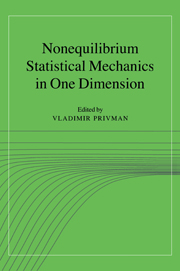Book contents
- Frontmatter
- Contents
- Contributors
- Preface
- Part I Reaction-Diffusion Systems and Models of Catalysis
- Part II Kinetic Ising Models
- Part III Ordering, Coagulation, Phase Separation
- Part IV Random Adsorption and Relaxation Processes
- Part V Fluctuations in Particle and Surface Systems
- Part VI Diffusion and Transport in One Dimension
- Part VII Experimental Results
- 20 Diffusion-limited exciton kinetics in one-dimensional systems
- 21 Experimental investigations of molecular and excitonic elementary reaction kinetics in one-dimensional systems
- 22 Luminescence quenching as a probe of particle distribution
- Index
- Abbreviations
22 - Luminescence quenching as a probe of particle distribution
Published online by Cambridge University Press: 18 December 2009
- Frontmatter
- Contents
- Contributors
- Preface
- Part I Reaction-Diffusion Systems and Models of Catalysis
- Part II Kinetic Ising Models
- Part III Ordering, Coagulation, Phase Separation
- Part IV Random Adsorption and Relaxation Processes
- Part V Fluctuations in Particle and Surface Systems
- Part VI Diffusion and Transport in One Dimension
- Part VII Experimental Results
- 20 Diffusion-limited exciton kinetics in one-dimensional systems
- 21 Experimental investigations of molecular and excitonic elementary reaction kinetics in one-dimensional systems
- 22 Luminescence quenching as a probe of particle distribution
- Index
- Abbreviations
Summary
When the metal complex [Ru(phen)2(dppz)]2+ is bound to DNA it can luminesce. If the metal complex [Rh(phi)2(phen)]3+ is nearby on the strand, the luminescence is quenched by electron transfer. By varying concentrations and by varying the DNA it is possible to probe the distribution of complexes in this one-dimensional (1D) system, and to gather information about the electron transfer length and interparticle forces. Our model assumes random deposition with allowance for interactions among the complexes. Long strands of calf thymus (CT) DNA and short strands of a synthetic 28-mer were used in the experiments and, for fixed [Ru(phen)2(dppz)]2+ concentration, quenching was measured as a function of [Rh(phi)2(phen)]3+ concentration. In previous work, to be cited later, we reported an electron transfer length based on the CT-DNA data. However, the short-strand (28-mer) experiments show a remarkable difference from the previously analyzed data. In particular, the electron-transfer quenching upon irradiation is enhanced by a factor of approximately four. This requires the consideration of new physical effects on the short strands. Our proposal is to introduce complexcomplex repulsion as an additional feature. This allows a reasonable fit within the context of the random-deposition model, although it does not take into account changes in the structure of the 28-mer introduced by the metal complexes during the loading process.
- Type
- Chapter
- Information
- Nonequilibrium Statistical Mechanics in One Dimension , pp. 443 - 460Publisher: Cambridge University PressPrint publication year: 1997
- 3
- Cited by



